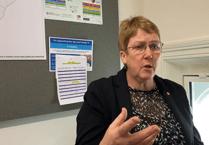A new ‘Climate Adaptation Toolkit’ has been launched to help Pembrokeshire communities prepare for the impacts of climate change, with the seaside village of Saundersfoot leading the way as the first to pilot the locally-led approach.
The Toolkit, developed by the Pembrokeshire Coastal Forum, brings together practical resources to help communities understand the risks they face – from coastal flooding to increased risk of wildfire – and to help communities work with key stakeholders to co-create their own local adaptation plans.
It includes free-to-access guides, templates, a network for action, and mapping tools designed to support place-based, community-led climate action.
“This is about turning concern into action,” said Tom Luddington, Coastal Stakeholder Manager at Pembrokeshire Coastal Forum.
“Coastal communities are on the frontline of climate change as sea levels rise, and we are seeing more intense storms, increased risk of wildfire, and heavier rain fall. The toolkit helps communities take the lead – because local knowledge, local leadership, and local collaboration are essential to building long-term resilience.”
Saundersfoot leads the way in a pilot project starting earlier this year, with the seaside village becoming the first community to trial the toolkit.
Stakeholders including - residents, local businesses, landowners, Natural Resources Wales, The Crown Estate, Mid and West Wales Fire and Rescue Service, Pembrokeshire National Park Authority, Saundersfoot Harbour Authority and Pembrokeshire County Council all came together to assess flood risks, share knowledge, and begin co-creating a local climate adaptation strategy.
This collaborative process has already begun to influence how local partners work together.
County Councillor for the village’s north ward, Cllr Alec Cormack described the pilot as “a good first step for how the Saundersfoot community can be more involved in co-creating climate adaptation plans - practical, inclusive, and with all the key stakeholders round the table.”
County councillor for Saundersfoot’s south ward Cllr Chris Williams said that he had attended the recent ‘Community Climate Adaptation Planning Meeting’ held at Saundersfoot Harbour, which discussed coastal erosion concerns.
Over the past couple of years, Saundersfoot Community Council has hosted ‘Sustainable Coastal Communities’ public meetings in collaboration with the Local Authority, to outline the challenges the seaside village will face in the future and to consider what actions may be possible to combat rising sea levels.
Feedback from residents has emphasized the need to balance short-term actions with long-term planning—potentially looking at many years ahead. Tourism has also been highlighted as a key part of the local economy, with the Strand playing a vital role in supporting this sector.
Also discussed has been the importance of improved shingle bank management, and sea defences, with the need to clarify permissions and responsibilities, especially with regard to private landowners, highlighted.
Following discussions at the most recent meeting last month, Cllr Williams provided a brief update with the aim to keep residents informed about the work being done in response to climate-related challenges in the coastal community.
He said that the key highlights from the meeting, included:
Emergency Response Focus Shift - “We heard from the Fire Officer, who explained the increasing need to focus on flood responserather than just fire. Emphasis was placed on pre-flood planning, community education, and reactive strategies to manage flood risks effectively.”
The Crown Estate Engagement - “A representative from The Crown Estate (TCE), which owns approximately 50% of the land between the mean high and low water marks, spoke about how coastal erosion is changing land boundaries. It was encouraging to hear TCE’s commitment to engage more directly with local communities.”
Land Ownership Presentation - “A clear and informative presentation on land ownership was shared, helping those unfamiliar with the area to better understand property layouts and jurisdiction.”
Action Planning and Priorities - “The group discussed short-term priorities, the potential to engage consultants for expert recommendations, and the exploration of long-term funding, possibly through grant-supported community adaptation projects.”
Flood Defence Ideas - “Suggestions included improving the shingle bank and investigating how gabion basketsmight help protect vulnerable properties. All proposals must be aligned with nationalbiodiversity and net gain commitments.
Feasibility Study and Inclusion - “A feasibility study was proposed, with a strong emphasis on ensuring that residents and businesses on The Strand lead any conversation.”
For the next steps, Cllr Williams said that the main working group will pause until September.
“In the meantime, Cllr Alec Cormack and I will continue to liaise with residents and business owners on The Strand and work towards coordinating a focused engagement group, ensuring all voices are heard and involved in shaping future action,” he added.
Although Pembrokeshire focussed, the new toolkit has clear relevance across Wales and beyond. With more than 60% of the Welsh population living near the coast, and extreme weather events on the rise, the need for place-based planning has never been more urgent.

The Welsh Government’s own risk assessments highlight flooding, coastal erosion, and loss of infrastructure as growing threats.
In response, the Pembrokeshire Coastal Forum’s toolkit provides a scalable model that empowers communities to shape their own responses – while aligning with national policies like the Well-being of Future Generations Act and the Climate Adaptation Strategy for Wales launched in 2024.
WWF Cymru are funding the next stage of the project as part of their Wholescape Programme in Pembrokeshire.
Jessica McQuade, Programme Manager said: "This climate adaptation work in Saundersfoot offers a demonstration project of how we can tackle the triple challenge of climate change, nature loss and community wellbeing.
“The toolkit, and the wider Pembrokeshire Climate Adaptation Plan has the potential to show best practice to the rest of Wales but we need to fund and test its implementation. It is very important to be activity supporting communities to be resilient to climate change, taking a nature based approach where possible. We are really excited to be part of this project."
What the toolkit includes The full Climate Adaptation Toolkit, now available online, is organised into four sections:
- Learning Hub – Insight into local climate risks and how to talk about them
- Community Action – Step-by-step guides and tools to help communities plan adaptation measures
- Network for Action – Links to organisations, funding routes, and support networks
- Resources – Downloadable templates, maps, and facilitation materials
The aim is to make climate adaptation accessible for anyone who wants to help prepare their community for the future.
With positive feedback from the Saundersfoot pilot, PCF plans to expand the rollout to more areas.
The team is also inviting partnerships with local authorities, town and community councils, and environmental organisations across Wales to adopt and adapt the model to their own local needs.
“This is about empowering people,” continued Tom Luddington.
“If we want climate adaptation to be effective, it has to be something communities shape for themselves with support from Welsh Government and all key stakeholders.”
The Climate Adaptation Toolkit is free to access via: www.pembrokeshirecoastalforum.org.uk/climate-adaptation-toolkit
Pembrokeshire Coastal Forum is a multi-award-winning Community Interest Company established in 2000 in response to the Sea Empress oil spill.
This environmental disaster – alongside offshore oil exploration and increasing recreational and commercial pressures – highlighted the urgent need for an independent, trusted body to bring people together around the challenges facing our coast.
Since then, PCF has grown into a leading force for sustainable coastal management – connecting communities, industry, and decision-makers to protect and enhance our marine and coastal environments.





Comments
This article has no comments yet. Be the first to leave a comment.